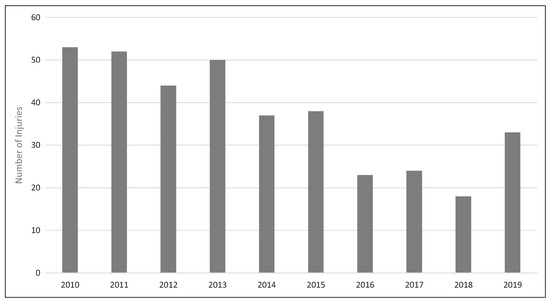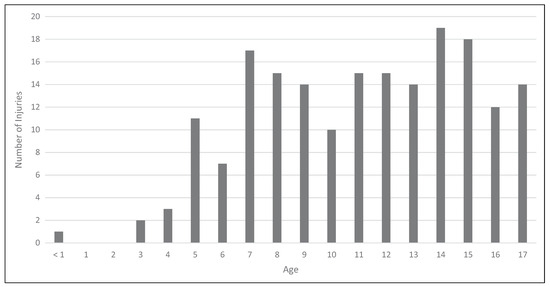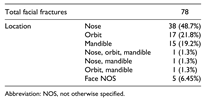Abstract
Study Design: Retrospective descriptive observational study. Purpose: Skiing and snowboarding offers valuable opportunities for outdoor physical activity throughout the cold winter months, but these activities can result in substantial personally injury. This study aimed to analyze trends in skiing and snowboarding-related facial trauma epidemiology. Methods: The National Electronic Injury Surveillance System (NEISS) was queried for facial trauma related to skiing and snowboarding treated in United States (US) emergency departments between 2010 and 2019. These data and weighted estimates were used to analyze patient demographics, injury location, and etiology. Results: A total of 361 skiing or snowboarding-related facial injuries were recorded. Lacerations were most common injury (165/361; 45.7%), and facial fractures occurred in 21.6% (78/261) of patients. The most common facial fracture locations are the nose (38/78; 48.7%), orbit (17/78; 21.8%), and mandible (15/78; 19.2%). Pediatric patients accounted for 52% (187/361) of these injuries and had higher rates of lacerations (51.9% vs 39.1%, P < 0.05) and hospital admission (4.8% vs 1.15%, P < 0.05) than adults. Adults had a higher rate of facial fracture (30% vs 13.9%, P < 0.001) than children. Conclusions: Skiing and snowboarding-related facial trauma is relatively uncommon in the US. In general, these injuries are largely decreasing, but facial fractures still occur not infrequently during these activities. Based on our data, we strongly urge helmet manufacturers to increase the availability of recreational snowsport helmets that include nose, orbit, and mandible protections, which could help to prevent many of these injuries.
Keywords:
skiing; snowboarding; face; trauma; NEISS database; craniofacial; maxillofacial; nose fracture; jaw fracture; orbit fracture Introduction
Skiing and snowboarding offers valuable opportunities for outdoor physical activity throughout the coldest winter months of the year, and these sports, along with other winter activities such as snow tubing and snowshoeing, attract about 10% of the United States population yearly, up to 25 million Americans in 2019.1 However, these activities are not wholly benign and can result in substantial personally injury, with up to 25 percent of participants previously having been found to require care from a hospital-based trauma service.2 In this study, we aim to investigate the epidemiology of skiing and snowboarding-related face trauma presenting to a representa- tive sample of emergency departments (EDs) in the United States and make a case for increased availability of facial protections to use during participation in these activities.
Materials and Methods
Study Design and Population
The authors retrospectively analyzed information in the U.S. Consumer Product Safety Commissions’ National Elec- tronic Injury Surveillance System (NEISS) database for patients treated between January 1, 2010, and December 31, 2019. The NEISS is comprised of a stratified probability sample of 100 hospitals in the United States and its territories and is maintained by the US Consumer Product Safety Commission (CPSC).3-5 Stratification is by ED annual census and geographic region. Each ED is assigned a statistical weight to represent others in the same ED census stratum. The statistical weight represents the inverse of the probability of selection of EDs in each census stratum. Each injury case from a participating ED represents the same number of injuries as the statistical weight of the ED. Weighted data are summed to generate national estimates.
Measurements
The NEISS database collects information on the date, age, sex, diagnosis, body part, patient disposition, involved con- sumer products, location of incident and a free-text descrip- tion for each related injury treated in the ED. This information is entered into computers in the EDs and uploaded each night into the Consumer Product Safety Commission computer database. For this study, the authors queried the NEISS database for all injuries recorded as “face,” “skiing-related,” and “snowboarding-related” over the 10-year study period. Results were obtained in 1-year increments and combined for overall analysis (n). These analyses were repeated to sex, age, and facial fracture subgroups.
Statistical Analysis
Descriptive statistics were reported as a mean or median and standard deviation for continuous variables or frequency and percentage for categorical variables, respectively. Com- parisons of means were performed with a two-tailed T-test; comparisons of proportions were performed with an “N-1” Chi-squared test. Before performing any tests, statistical significance was defined with a p-value < 0.05. All statistical analyses were performed using commercially available soft- ware (JMP 13, SAS, Inc.)
Results
A total of 361 skiing and snowboarding-related primary facial injuries were recorded in the ED during the 10-year study period. Sixty-eight percent (244/361) of these injuries occurred in male patients, and the mean (+ standard deviation [SD]) age was 21.1 (+ 14.5) years. The most common race to suffer facial injuries was white (259/361; 71.7%). The most common injury diagnosis was laceration (165/361; 45.7%). The most common disposition from the ED was treated and discharged (340/361; 94.2%). Full demographic data are described in Table 1. The inci- dence of facial injuries steadily declined from 53 to 18 between 2010 and 2018 before increasing again to 33 in 2019 (Figure 1). Over this study period, the head: face injury ratio was 6:1.

Table 1.
Demographic Data.

Figure 1.
Incidence of skiing and snowboarding-related facial injuries presenting to United States Emergency Departments over the study period.
Age-Related Trends
Of the total primary facial fractures recorded, all had age recorded. The youngest patient was 11 months old and the oldest patient was 80 years old. Pediatric patients (age < 18 years) accounted for 52% of recorded injuries (187/361) and had mean (SD) age of 11.1 (3.8) years. The most common age of injury (n ¼ 19) was 14 years (Figure 2). Children had a higher incidence of lacerations (51.9% vs 39.1%, P < 0.05), and adults had higher incidence of fracture (30% vs 13.9%, P < 0.001). Additionally, after being seen in the ED, children were more likely to be admitted than adults (4.8% vs 1.15%, P < 0.05). There was a reported on-scene or ED fatality rate of 0% (Table 2).

Figure 2.
Incidence of pediatric skiing and snowboarding-related facial injuries per 1-year age stratum presenting to United States Emergency Departments over the study period.

Table 2.
Comparison of Injury Types Between Adults (18 Years and Older) and Children (17 Years and Younger) a.
Sex-Related Trends
Of the total primary facial injuries, all had sex recorded. On average, there was no significant difference in age between the sexes. Facial laceration was the most common type of injury for both males and females. Female patients were more likely to experience facial contusion (31.6% vs 20.5%, P < 0.05) than male patients. Male patients were more likely to experience facial laceration (51.6% vs 33.3%, P < 0.01). Male patients were more likely to be treated and discharged than females (96.3% vs 89.7%, P < 0.05). There were no other statistically significant differences observed in post-ED dispositions between males and females (Table 3).

Table 3.
Comparison of Age, Injury Types, and Disposition Between Males and Females a.
Facial Fractures
There were 78 primary facial fractures recorded in the EDs over the 10-year study period. The most common fractures were the nose (38/78; 48.7%), orbit (17/78, 21.8%) and mand- ible (15/78, 19.2%). Full facial fracture data are available in Table 4.

Table 4.
Characterization of Facial Fractures.
Discussion
The aim of this study was to investigate the epidemiology of skiing and snowboarding-related injuries in the United States presenting for emergency care over a 10-year period from 2010 to 2019. There were 361 facial injuries recorded in the ED during the study period, and our data suggest that most skiing and snowboarding-related facial trauma are lacerations that occur to young adult male patients. We observed that the number of facial injuries declined over the first 9 years of study before increasing again. Over half of the facial injuries took place in children (187/361; 52%), and these children have a higher rate of lacerations (51.9% vs 39.1%, P < 0.05) and were more likely to be admitted to the hospital (4.8% vs 1.15%, P < 0.05) than adults.
However, adults have a higher rate of facial fracture (30% vs 13.9%, P < 0.001). Comparing males and females, male patients were more likely to suffer lacerations (51.6% vs 33.3%, P < 0.01), and female patients were more likely to suffer contusions (31.6% vs 20.5%, P < 0.05). When con- sidering primary facial fractures only, the most common fracture was the nose (38/78; 48.7%). Though previous study has utilized the NEISS to analyze snow-sport related facial injury, ours is the first to our knowledge to include adult and pediatric patients, focus only on skiing and snowboarding-related injuries, provide sex, and age sub-group analysis, and further characterize the facial fracture subgroup.
Variations in skiing and snowboarding-related facial trauma based on age appear to exist. We found that children are more likely to present to the ED with skiing or snowboarding-related facial injuries, as well as be admitted to the hospital for their injuries. Additionally, the incidence of injury with these children appears to peak twice around age 7 and age 14. With these data as a framework, these ages should be particularly targeted during well-child visits for preventative counseling on the importance of wearing protective equipment during recreational winter sporting activities. In particular, the adoption of protective gear that covers the head and face should be especially encouraged in children who ski and snowboard as our data and others’ have found that these activities have known risks of inju- ries, including lacerations, contusions, and fractures.6-9 Early counseling on the importance of safety equipment when children are young and willing to listen has great potential for playing an important role in reducing the peak of facial injuries at age 7 and, later, age 14.
There were also sex-based differences observed in skiing and snowboarding-related facial injuries. Maintain- ing the general trend, male patients presented to the ED at about a 2:1 ratio compared to women, though there was no significant difference in traumatic fracture rate between men and women. There was a difference in laceration and contusion rates, however, which is consistent with research performed on facial injuries sustained participating in other recreational activities.10-12 Interestingly, male patients were more likely to be treated and discharged that female patients, possibly suggesting that female injuries were of increased severity compared to male patients. Considering the high number of male injuries and possible increased severity of female skiing and snowboarding-related facial trauma, young adults of both sexes would make excellent targets for public health campaigns aimed at increasing helmet and face protection usage during risky recreational activities.
Winter outdoor recreational activities, such as skiing and snowboarding, are currently as popular as ever, the data suggests that they are also much safer. The number of skiing and snowboarding-related facial injuries pre- senting to the EDs decreased in incidence by 66% over the first 9 years of the study. We would hypothesize that the trend is due to improved helmet designs and increased helmet usage by participants, which previous literature has suggested reduces risk of serious head injury, facial and/or skull fracture.11,13 However, though the general population is increasingly adopting helmet usage to protect the skull and calvarium against head injuries, little progress has been made to safeguard the face against injuries, which occurred only slightly less frequently than head injuries over the study period. Injury analysis of ice hockey, an injury-prone winter sport, found that facial and dental injuries are signifi- cantly more likely in players who do not wear visors14 or full face shields.15 Thus, steps have been taken to readily incorporate these protections in routinely-worn equipment at all levels, including mandatory use of head and face protections at a youth level, and these changes have all but eliminated facial injuries in youth hockey.16 We implore that snowsport helmets follow this lead and readily incorporate facial protections that could help protect against many of these injuries.
The current study has several limitations. First, though the NEISS is a useful tool for computing population health care trends, this database only records injuries in persons who present for emergency care; thus, patients who do not seek medical care, or first present to a physician in an out- patient setting are not accounted for. Additionally, this database was originally created as a consumer protection device to report injuries occurring from product and equip- ment usage, so its design is not perfectly suited for nation- wide epidemiologic studies since the choice of hospitals to include in the database can certainly skew smaller popula- tion injury rates. Nevertheless, to our knowledge, this study represents the first nationwide epidemiologic study to date that characterizes skiing and snowboarding-related facial injuries presenting for emergency care.
Conclusions
Skiing and snowboarding-related facial trauma is relatively uncommon in the US. In general, these injuries are largely decreasing, but facial fractures still occur not infrequently during these activities. With these data in mind, we strongly urge commercial helmet manufacturers to incorporate nose, orbit, and mandible protections more readily in their recreational product designs and make a public health plea for their increased availability, which we believe could help to prevent many of these injuries.
Declaration of Conflicting Interests
The author(s) declared no potential conflicts of interest with respect to the research, authorship, and/or publication of this article.
Funding
The author(s) received no financial support for the research, authorship, and/or publication of this article.
References
- Physical Activity Council. 2020 physical activity council’s overview report on U.S. participation. Published 2021. Accessed , 2020. https://eb6d91a4-d249-47b8- a5cb-933f7971db54.filesusr.com/ugd/286de6_c28995b76cf 94de2a22ac7a0a4d5264d. 14 December.
- Skokan EG, Junkins EP, Kadish H. Serious winter sport injuries in children and adolescents requiring hospitalization. Am J Emerg Med. [CrossRef]
- U.S. Consumer Product Safety Commission Division of Hazard and Injury Data Systems. The National Electronic Injury Surveillance System: a tool for researchers. Published 2021. Accessed , 2020. https://www.cpsc.gov/ Research–Statistics/NEISS-Injury-Data. 14 December.
- U.S. Consumer Product Safety Commission Division of Hazard and Injury Data Systems NEISS coding manual. Published 2021. Accessed , 2020. https:// www.cpsc.gov/s3fs-public/2019_NEISS_Coding_Manual. pdf. 14 December.
- Schroeder T, Ault K, U.S. Consumer Product Safety Com- mission Division of Hazard and Injury Data Systems. The NEISS sample (design and implementation) 1997 to present. Published 2021. Accessed , 2020. https://www. cpsc.gov/s3fs-public/pdfs/blk_media_2001d011-6b6.pdf. 14 December.
- Svider PF, Bobian M, Hojjat H, et al. A chilling reminder: pediatric facial trauma from recreational winter activities. Int J Pediatr Otorhinolaryngol. [CrossRef]
- Tuli T, Haechl O, Berger N, et al. Facial trauma: how dan- gerous are skiing and snowboarding? J Oral Maxillofac Surg. [CrossRef]
- Provance AJ, Daoud AK, Tagawa A, Rhodes J. Pediatric and adolescent injury in skiing. Res Sports Med, 1: 1). [CrossRef]
- Federiuk CS, Schlueter JL, Adams AL. Skiing, snowboard- ing, and sledding injuries in a northwestern state. Wilderness Environ Med.
- Døving M, Galteland P, Eken T, et al. Dentoalveolar injuries, bicycling accidents and helmet use in patients referred to a Norwegian trauma Centre: a 12-year prospective study. Dent Traumatol, 2020. [CrossRef]
- Frenkel B, Bahouth H, Abu Shqara F, Rachmiel A. Cranio- facial injuries seen among electric-motorized bicycle riders. J Craniofac Surg, 2: online. 2020;31(8), 2020. [CrossRef]
- Moshy JR, Msemakweli BS, Owibingire SS, Sohal KS. Pattern of mandibular fractures and helmet use among motor- cycle crash victims in Tanzania. Afr Health Sci. [CrossRef]
- Alfrey EJ, Tracy M, Alfrey JR, et al. Helmet usage reduces serious head injury without decreasing concussion after bicycle riders crash. J Surg Res. [CrossRef]
- Micieli JA, Zurakowski D, Ahmed IIK. Impact of visors on eye and orbital injuries in the National Hockey League. Can J Ophthalmol. [CrossRef]
- Benson BW, Mohtadi NG, Rose MS, Meeuwisse WH. Head and neck injuries among ice hockey players wearing full face shields vs half face shields. JAMA, 2328. [CrossRef]
- Murray TM, Livingston LA. Hockey helmets, face masks, and injurious behavior. Pediatrics.
Disclaimer/Publisher’s Note: The statements, opinions and data contained in all publications are solely those of the individual author(s) and contributor(s) and not of MDPI and/or the editor(s). MDPI and/or the editor(s) disclaim responsibility for any injury to people or property resulting from any ideas, methods, instructions or products referred to in the content. |
© 2025 by the authors. Published by MDPI on behalf of the AO Foundation. Licensee MDPI, Basel, Switzerland. This article is an open access article distributed under the terms and conditions of the Creative Commons Attribution (CC BY) license (https://creativecommons.org/licenses/by/4.0/).
